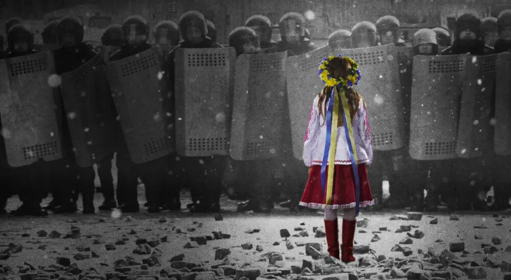Winter on Fire: Ukraine’s Fight for Freedom (2015)
‘Winter on Fire: Ukraine’s Fight for Freedom’. Pic: PCMag
Evgeny Afineevsky’s harrowing documentary is more relevant than ever.
It is easy to see how Winter on Fire scored 8.4/10 on IMDb. Its raw, emotional portrayal of the civil unrest in Kyiv from 2013-2014 earned it an Oscar nomination. But awards do it little justice. Filmed in shocking detail, the moment-by-moment account is eye-opening. In light of recent events, this documentary is one to watch for an understanding of Ukraine’s past. It is an accurate depiction of the violence that occurred, and viewers should be advised that it involves frequent graphic content. That being said, it is important not to shy away from the reality of brutality in Kyiv.
Following the chronological order of events as they unfold in Kyiv, Afineevsky gets up-close and personal with the politics and emotions involved. The unrest was caused by the former president, Viktor Yanukovych, when he did a U-turn on his promise to sign a free-trade deal with the EU, and opted for cooperation with the Russian Federation instead. This film chronicles the people of Ukraine upholding their desire to remain democratic in the face of totalitarian pressure.
The film opens on the frontline. A protestor calls his mother to tell her that he loves her. Suddenly, we go back to the beginning. Starting with peaceful protests, we watch as the people of Ukraine rally together in defence of independence and human rights. But as police get involved, the tone shifts, and the spiral of violence is set off. The sequential narrative of the film allows us to experience the conflict moment by moment, as each attempt at a peaceful protest by the Euromaidan is met with colossal brutality.
The most hard-hitting aspect of this film is the depiction of violence. It is deeply unforgiving. Never have I seen such an honest account of conflict. We see people beaten with iron poles, rocks thrown at their heads, and eventually, protestors being shot and killed in front of our eyes. The violence is alarming. Afineevsky shows us, brutally, what no news station could (or would) at the time.
Interviews with activists cause heartache as we are forced to grapple with the mass of the situation on a human level. The way in which the film engages the audience in the conflict is effective, and allows us to empathise. Using a blend of mobile phone footage and professionally filmed footage, the film gets the real story from multiple angles.
The moments in which thousands of Ukrainians sing their national anthem in defiance of violence, with conflict surrounding them, is overwhelming. The national anthem is sung multiple times throughout; every time it is more emotional than the last as the frustration of the movement is felt and more lives are lost.
By the end of the film, the people have managed to force Yanukovych to flee (to Russia), and the hope for democracy is restored. But, in the final moments, as death and injury tolls are totalled, it is made clear that the conflict is not over. Instead, it moved to the annexation of Crimea. A line can be drawn from current events back to the tragedy in 2013/14, making the film increasingly relevant. What the film teaches us is that the power of the people is mighty when arms are linked with neighbours. We are left with a lingering spirit of defiance; spurred on by the people of Ukraine’s unwavering hope for the future, and belief in its people.
This film is available to watch on Netflix.
